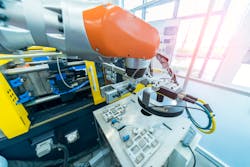Embedded vs. machine vision systems in factory automation
Your customer has requested a vision system to be included in the machine design to assist with some step of the process or to determine pass/fail conditions of a piece of ware in the system or for some other important reason. When researching and specifying a vision system for manufacturing systems, you will quickly see that there are two major categories of systems—machine vision and embedded vision. It can become somewhat confusing to understand the definitions, differences, advantages and best applications of each and also where the boundary exists between the two systems.
Machine vision
Traditional machine-vision systems are typically comprised of four components: a standalone camera, a standard communication interface, a PC running image-processing software and some type of consistent lighting for the camera.
The camera is typically fairly generic, although it may be equipped with specific filters, and the image-capture element, either charge-coupled device (CCD) or complementary-metal-oxide-semiconductor (CMOS), can be selected based on various resolutions or wavelengths of interest.
Finally, the piece being examined is illuminated by the appropriate lighting source. The camera is normally fairly bulky and has a visible glass lens. A personal computer (PC), typically server-class, runs image-processing software that can be configured to output specifics to the automation or robotic controller about the ware being examined to the automation or robotic controller.
The PC and camera are connected by a standard interface, such as Ethernet or a coax-based protocol. These systems have been around since the 1970s and are still very applicable to many fixed systems in automation, such as pick-and-place robotics, printed-circuit-board (PCB) examination and other defect detection in numerous types of manufacturing.
Each component of the system is fairly generic, and, thus, there is the ability to mix and match different cameras, PCs and image-processing software in the system. However, the size and cost of these components are fairly substantial. Also, their applicability for low power, small form factor or mobile applications is very limited.
Embedded vision
In the past, there were no other options for systems other than the traditional machine vision system, and, unfortunately, the size and power requirements of the components hindered the use of vision in applications requiring either low cost, small form factor or mobile applications. With the advent and evolution of smaller but powerful processors found in notebook computers and, more importantly, cell phones, the standalone PC was no longer required, and miniaturization of camera elements, also evolved from the same consumer devices, allowed the advent of embedded-vision systems.
These systems tend to be much smaller, less expensive and consume less power but are more specialized than their traditional counterparts. The camera portion can be a small PCB assembly connected via a small cable to, or even part of, an integrated processor and image-processing unit tailored to specific applications.
Effectively the system is replaced by an edge-processing device with a vision system on chip (SoC) and some artificial-intelligence (AI) algorithms. Examples are wide-ranging, from drone vision systems and medical skin-growth analyzers to grocery-store checkout cameras that automatically identify produce and even facial-recognition applications. Automated inventory systems use embedded vision to examine bins for part counts and navigate autonomous warehousing vehicles. The applications of embedded systems continue to grow as the sophistication of the systems continues to increase.
Evolution continues
Obviously, vendors are still supplying both types of systems, and both systems still have their place in manufacturing and industry. As both systems evolve, the defining line between the two may continue to appear to blur. Traditional machine-vision-system cameras will continue to miniaturize, and on-board image processing will become a feature of the cameras.
Programmable logic controllers (PLCs) and proprietary automation controllers are being replaced by standard multi-core PC architectures, allowing the connection of the camera directly to the automation controller and running the same image-processing software on the main automation controller. This obviates the need for a dedicated server-class PC for image processing.
Conversely, embedded vision systems will continue to become more powerful as processors evolve and will include more adaptable image-processing capabilities and more features that bridge the lines between the two systems even further.
How to choose
For now, traditional machine-vision systems are very applicable to human-vision-type applications, such as defect detection for quality control, ware placement and orientation for pick-and-place robotics, ware alignment, robotic welding, assembly and similar industrial applications.
Embedded systems will lend themselves best for applications involving small form factor, low power consumption and mobile applications. Also, very application-specific areas involving AI are prime candidates for embedded vision systems.
About the Author

Joey Stubbs
contributing editor
Joey Stubbs is a former Navy nuclear technician, holds a BSEE from the University of South Carolina, was a development engineer in the fiber optics industry and is the former head of the EtherCAT Technology group in North America.

Leaders relevant to this article:
